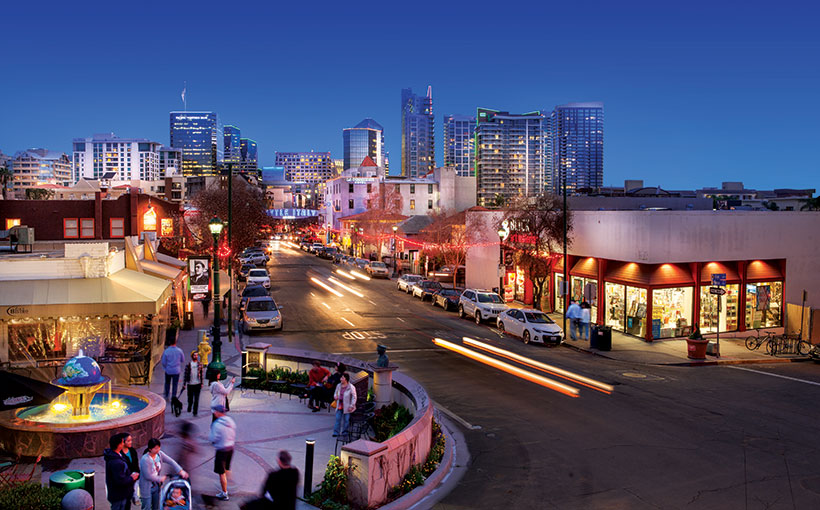What started out as a small fishing colony is now the largest Little Italy in the country. It’s a model urban neighborhood—a mix of old and new, trendy and traditional, in everything from restaurants to developments to the residents themselves. Little Italy has built up over the years, but dedicated community leaders, like Marco Li Mandri of the Little Italy Association, have worked to ensure historic building facades still line the streets. Its focus now turns toward adding residential and public spaces.
Late 1800s
A neighborhood is born. The first Italian immigrants settle in search of promising fishing grounds. Like much of San Diego, the economy is largely dependent on the bay.
1888
The oldest house still standing in Little Italy is built at 1918 India St. By 2017 the exterior remains, but the inside has been converted into a wine bar.
1910–1920
Fishermen start thinking big. A sardine shortage prompts them to seek out a new catch: tuna. San Diego is known for a time as the Tuna Capital of the World.
1925
Our Lady of the Rosary Church opens and soon becomes the neighborhood’s civic center. It’s home to the only elementary school downtown.
1933
San Diego’s oldest tavern, The Waterfront, opens on Kettner Boulevard.
“It’s ironic that they didn’t do a straight line that went from Little Italy to Barrio Logan. They preserved the commercial properties but destroyed the old community.”
1939–1945
World War II is in full swing. Italians are subject to a curfew under suspicion of espionage. Tuna boats are seized for use by the military.
1950
The market that’s now Filippi’s Pizza Grotto opens. Current owner Danny Moceri says the hanging wine bottle tradition started as a credit system for fishermen, which was not a hit. The market turned to cash and carry and later became a restaurant.
1950s
Construction begins on I-5. “It’s ironic that they didn’t do a straight line that went from Little Italy to Barrio Logan,” Li Mandri says. “They preserved the commercial properties but destroyed the old community.”
1970s
The end is near for the tuna industry in San Diego due to stricter fishing regulations and increased foreign competition.
1980s
Little Italy neighborhoods across the US are on the decline or have disappeared altogether. “We were one of just a handful left,” Li Mandri says.
“Places like Little Italy are important because of the social value, not because things are cheap here.”
1990s
Little Italy residents are more connected than ever to the rest of San Diego when the neighborhood gets a trolley stop.
1998
The neighborhood hosts its first organized stickball tournament.
2000
The iconic Little Italy sign goes up over India Street, which has a lane removed, diagonal parking added, and stop signs installed, helping it become a pedestrian-friendly promenade.
Mid 2000s
Bike racks start going up. “The more walkable communities in the country will be the most successful ones,” Li Mandri says.
2003
Piazza Basilone opens as a tribute to the neighborhood’s “boys that never came home,” named for Marine Corps Gunnery Sgt. John Basilone, a Medal of Honor recipient killed in the Battle of Iwo Jima.
“The more walkable communities in the country will be the most successful ones.”
2010s
Local retailers feel the sting from online competition. “Places like Little Italy are important because of the social value, not because things are cheap here,” Li Mandri says.
2011
Mercato Farmers’ Market lines the streets with fresh produce and local crafts for the first time.
2013
The neighborhood gets its first craft brewery tasting room, Ballast Point.
A valet service is launched as a way to address parking scarcity, funded by parking meter revenue. “The number of parking spaces in Little Italy really hasn’t changed,” Li Mandri says.
2015
Little Italy launches its very own app with everything you’d need for a walking tour of the neighborhood, along with events and parking information.
Community leaders are coming up with ways to turn old into new. A house built on Date Street in the 1910s is turned into a restroom facility, then moved to Amici Park.
2018
Little Italy will get a new civic center called Piazza della Famiglia. Retail and residential space will be added to the mix and the neighborhood will keep evolving. Li Mandri says neighborhoods seeking to replicate Little Italy’s success must understand their history, establish a solid financial base, and have entrepreneurial district management.
Tags: Business, Innovation, Little Italy, Marco Li Mandri, On the Rise






























